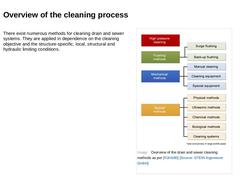
|
There exist numerous methods for cleaning drain and sewer systems. They are applied in dependence on the cleaning objective and the structure-specific, local, structural and hydraulic limiting conditions. (Image: Overview of the drain and sewer cleaning methods as per [Führb1980]) |
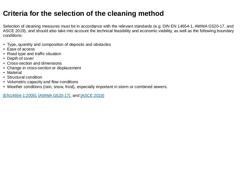
|
Selection of cleaning measures must be in accordance with the relevant standards (e.g. DIN EN 14654-1, AWWA G520-17, and ASCE 2019), and should also take into account the technical feasibility and economic viability, as well as the following boundary conditions: -
Type, quantity and composition of deposits and obstacles
-
Ease of access
-
Road type and traffic situation
-
Depth of cover
-
Cross-section and dimensions
-
Change in cross-section or displacement
|
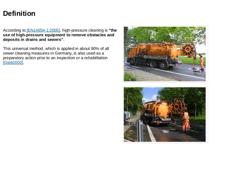
|
According to [EN14654-1:2005], high-pressure cleaning is "the use of high-pressure equipment to remove obstacles and deposits in drains and sewers". This universal method, which is applied in about 90% of all sewer cleaning measures in Germany, is also used as a preparatory action prior to an inspection or a rehabilitation [Geib2002]. (Image: Combined flushing/vacuum vehicle) (Image: Combined flushing/vacuum sewer cleaning vehicle) |
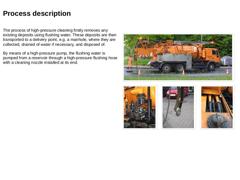
|
The process of high-pressure cleaning firstly removes any existing deposits using flushing water. These deposits are then transported to a delivery point, e.g. a manhole, where they are collected, drained of water if necessary, and disposed of. By means of a high-pressure pump, the flushing water is pumped from a reservoir through a high-pressure flushing hose with a cleaning nozzle installed at its end. (Image: Combined flushing/vacuum sewer cleaning … |
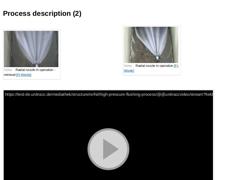
|
(Video: Radial nozzle in operation - retrieval) Animation: High pressure flushing process [Image: visaplan GmbH]. This interactive object is only visible in the online version of the module. (Video: Radial nozzle in operation [FI-Wiede]) Video: Radial nozzle in operation [FI-Wiede]. This interactive object is only visible in the online version of the module. Video: Radial nozzle in operation - retrieval [FI-Wiede]. This interactive element is only visible … |
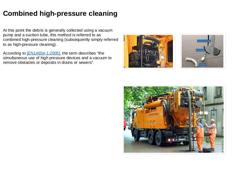
|
At this point the debris is generally collected using a vacuum pump and a suction tube, this method is referred to as combined high-pressure cleaning (subsequently simply referred to as high-pressure cleaning). According to [EN14654-1:2005], the term describes "the simultaneous use of high pressure devices and a vacuum to remove obstacles or deposits in drains or sewers". (Image: Vacuum-water-ring pump from the Super 2000 vehicle of the company Wiedemann & … |
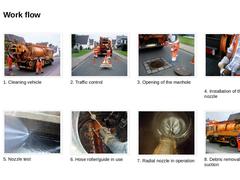
|
(Image: Sewer cleaning work flow - Cleaning vehicle) 1. Cleaning vehicle (Image: Sewer cleaning work flow - traffic control) 2. Traffic control (Image: Sewer cleaning work flow - Opening of the manhole) 3. Opening of the manhole (Image: Sewer cleaning work flow - Installation of the cleaning nozzle) 4. Installation of the cleaning nozzle (Image: Sewer cleaning work flow-Nozzle test) 5. Nozzle test (Image: Hose roller/guide in use) 6. Hose roller/guide in use |
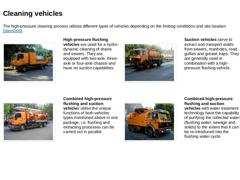
|
The high-pressure cleaning process utilises different types of vehicles depending on the limiting conditions and site location [SteinD00]. (Image: Cleaning vehicles - High pressure flushing vehicle) High-pressure flushing vehicles are used for a hydro-dynamic cleaning of drains and sewers. They are equipped with two-axle, three-axle or four-axle chassis and have no suction capabilities. (Image: Cleaning vehicles - Suction vehicle) |
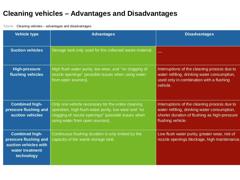
|
(Table: Cleaning vehicles – advantages and disadvantages) |
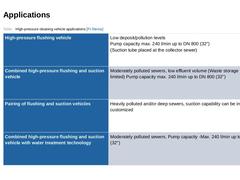
|
(Table: High-pressure cleaning vehicle applications) |
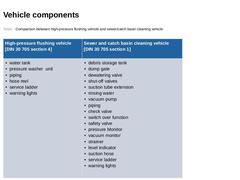
|
(Table: Comparison between high-pressure flushing vehicles and sewer and catch basin cleaning vehicle) |
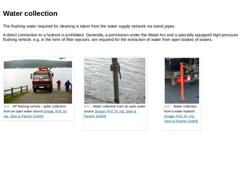
|
The flushing water required for cleaning is taken from the water supply network via stand pipes. A direct connection to a hydrant is prohibited. Generally, a permission under the Water Act and a specially equipped high-pressure flushing vehicle, e.g. in the form of filter ejectors, are required for the extraction of water from open bodies of waters. (Image: HP flushing vehicle - water collection from an open water source) (Image: Water collection from … |
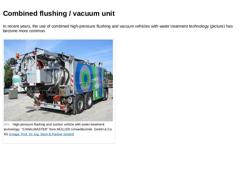
|
In recent years, the use of combined high-pressure flushing and vacuum vehicles with water treatment technology (picture) has become more common. (Image: High-pressure flushing and suction vehicle with water treatment technology) |
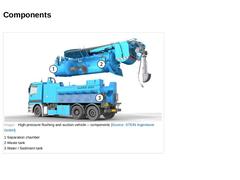
|
(Image: High-pressure flushing and suction vehicle – components) |
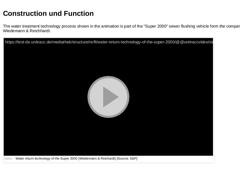
|
The water treatment technology process shown in the animation is part of the "Super 2000" sewer flushing vehicle form the company Wiedemann & Reichhardt. (Video: Water return technology of the Super 2000) Animation: Water return technology of the Super 2000 (Wiedemann & Reichardt) [Image: S&P GmbH]. This interactive object is only visible in the online version of the module. |
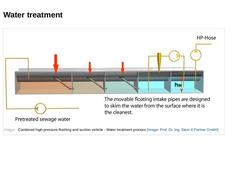
|
(Image: Combined high-pressure flushing and suction vehicle - Water treatment process) |
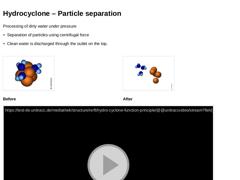
|
Processing of dirty water under pressure (Image: Dirt and water molecules prior to hydrocyclone treatment) Before (Image: Dirt and water molecules after the hydrocyclone treatment) After (Video: Hydro cyclone - Function principle) |
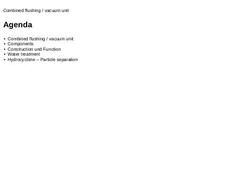
|
|
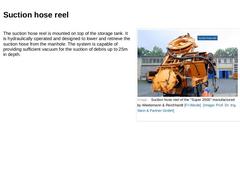
|
The suction hose reel is mounted on top of the storage tank. It is hydraulically operated and designed to lower and retrieve the suction hose from the manhole. The system is capable of providing sufficient vacuum for the suction of debris up to 25m in depth. (Image: Suction hose reel of the "Super 2000" manufactured by Wiedemann & Reichhardt) |
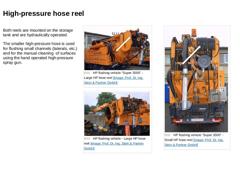
|
Both reels are mounted on the storage tank and are hydraulically operated. The smaller high-pressure hose is used for flushing small channels (laterals, etc.) and for the manual cleaning of surfaces using the hand operated high-pressure spray gun. (Image: HP flushing vehicle "Super 2000" - Large HP hose reel) (Image: HP flushing vehicle - Large HP hose reel) (Image: HP flushing vehicle "Super 2000" - Small HP hose reel) |
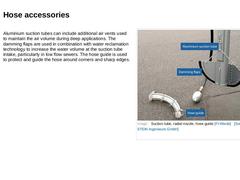
|
Aluminium suction tubes can include additional air vents used to maintain the air volume during deep applications. The damming flaps are used in combination with water reclamation technology to increase the water volume at the suction tube intake, particularly in low flow sewers. The hose guide is used to protect and guide the hose around corners and sharp edges. (Image: Suction tube, radial nozzle, hose guide) |
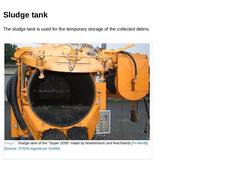
|
The sludge tank is used for the temporary storage of the collected debris. (Image: Sludge tank of the "Super 2000" made by Wiedemann und Reichhardt) |
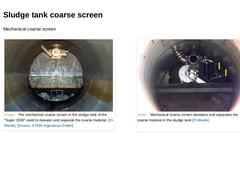
|
Mechanical coarse screen (Image: The mechanical coarse screen in the sludge tank of the "Super 2000" used to dewater and separate the coarse material.) (Video: Mechanical coarse screen dewaters and separates the coarse material in the sludge tank) Video: Mechanical coarse screen dewaters and separates the coarse material in the sludge tank [FI-Wiede]. This element is only visible in the online version of the module. |
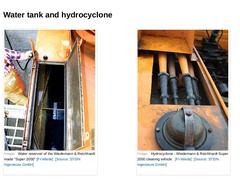
|
(Image: Water reservoir of the Wiedemann & Reichhardt made "Super 2000") (Image: Hydrocyclone - Wiedemann & Reichhardt Super 2000 cleaning vehicle) |
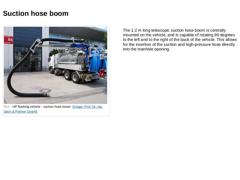
|
(Image: HP flushing vehicle - suction hose boom) The 1.2 m long telescopic suction hose boom is centrally mounted on the vehicle, and is capable of rotating 90 degrees to the left and to the right of the back of the vehicle. This allows for the insertion of the suction and high-pressure hose directly into the manhole opening. |